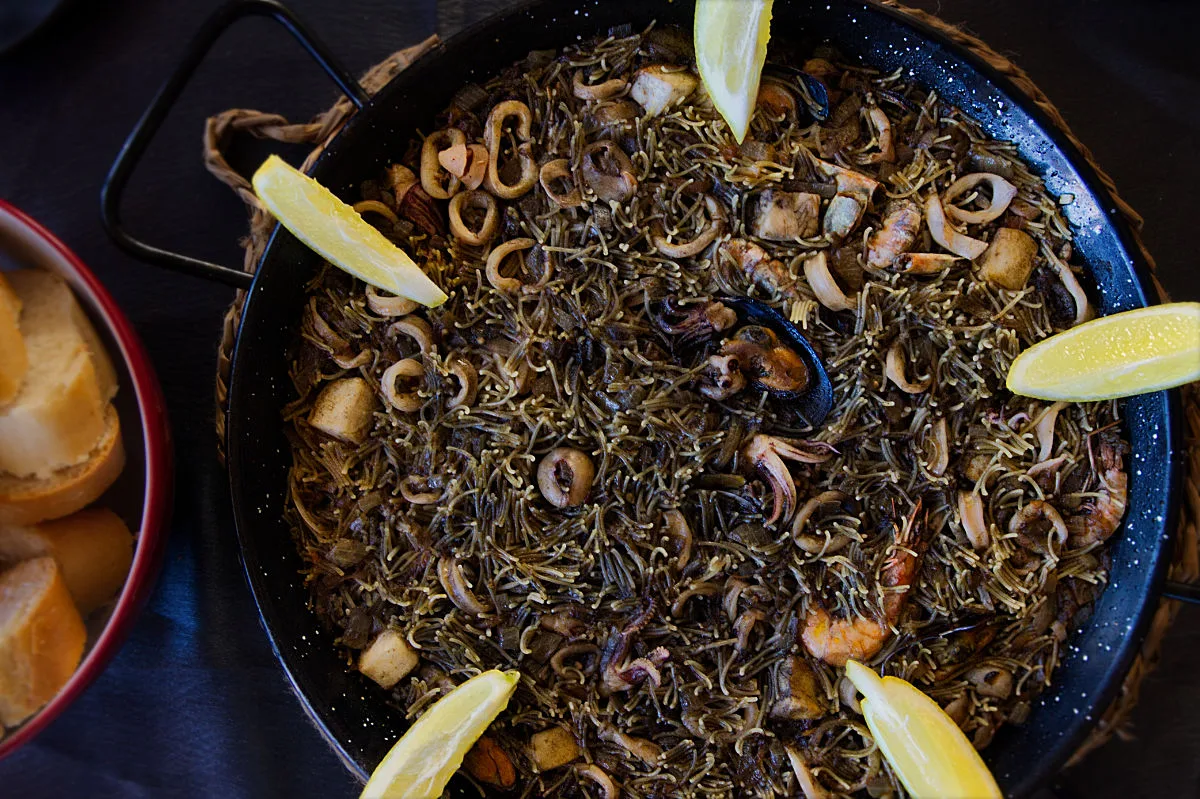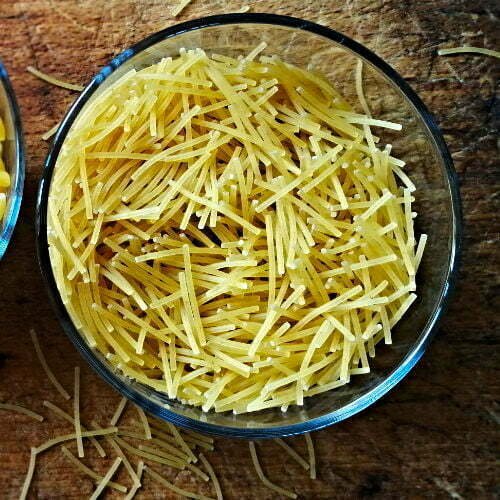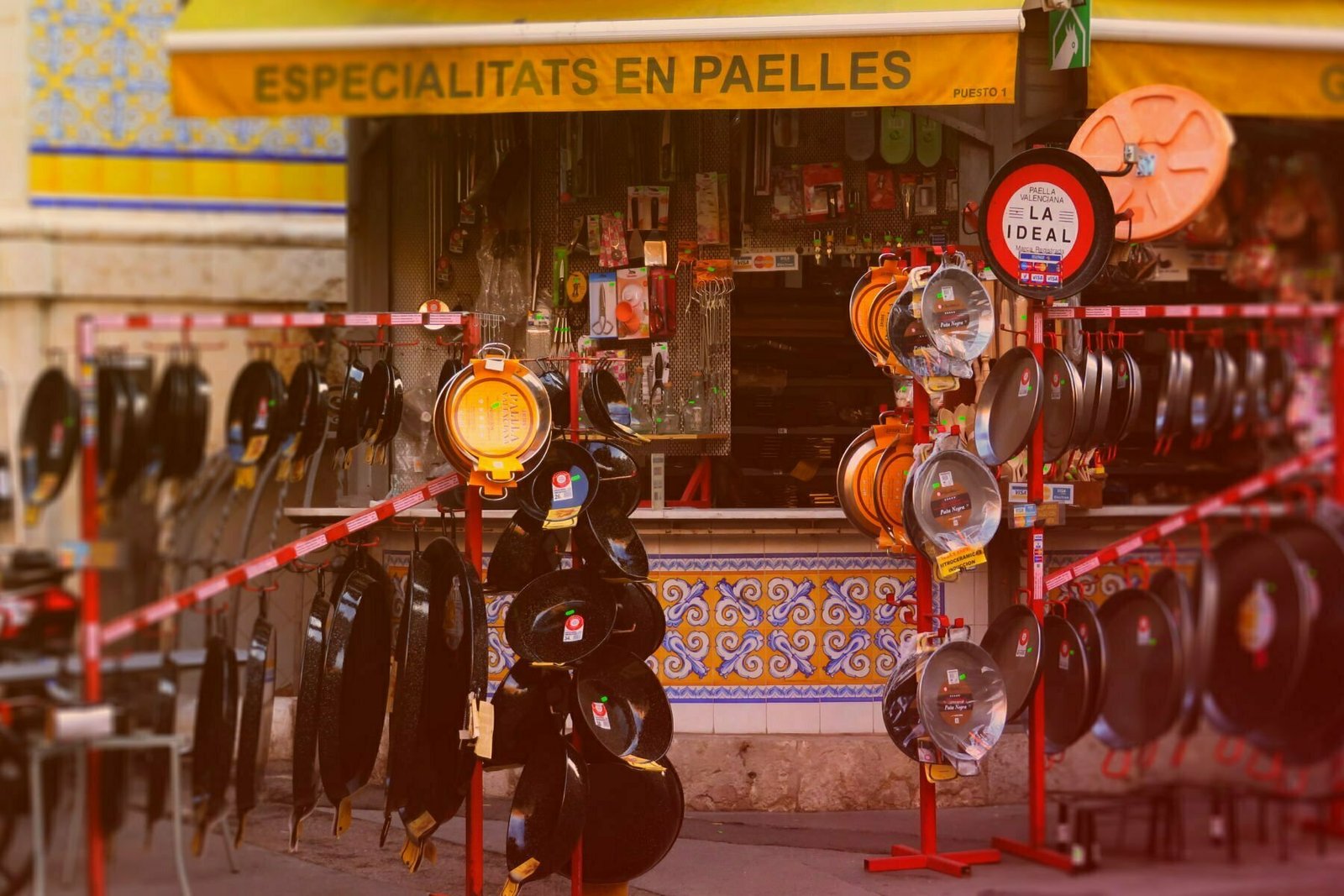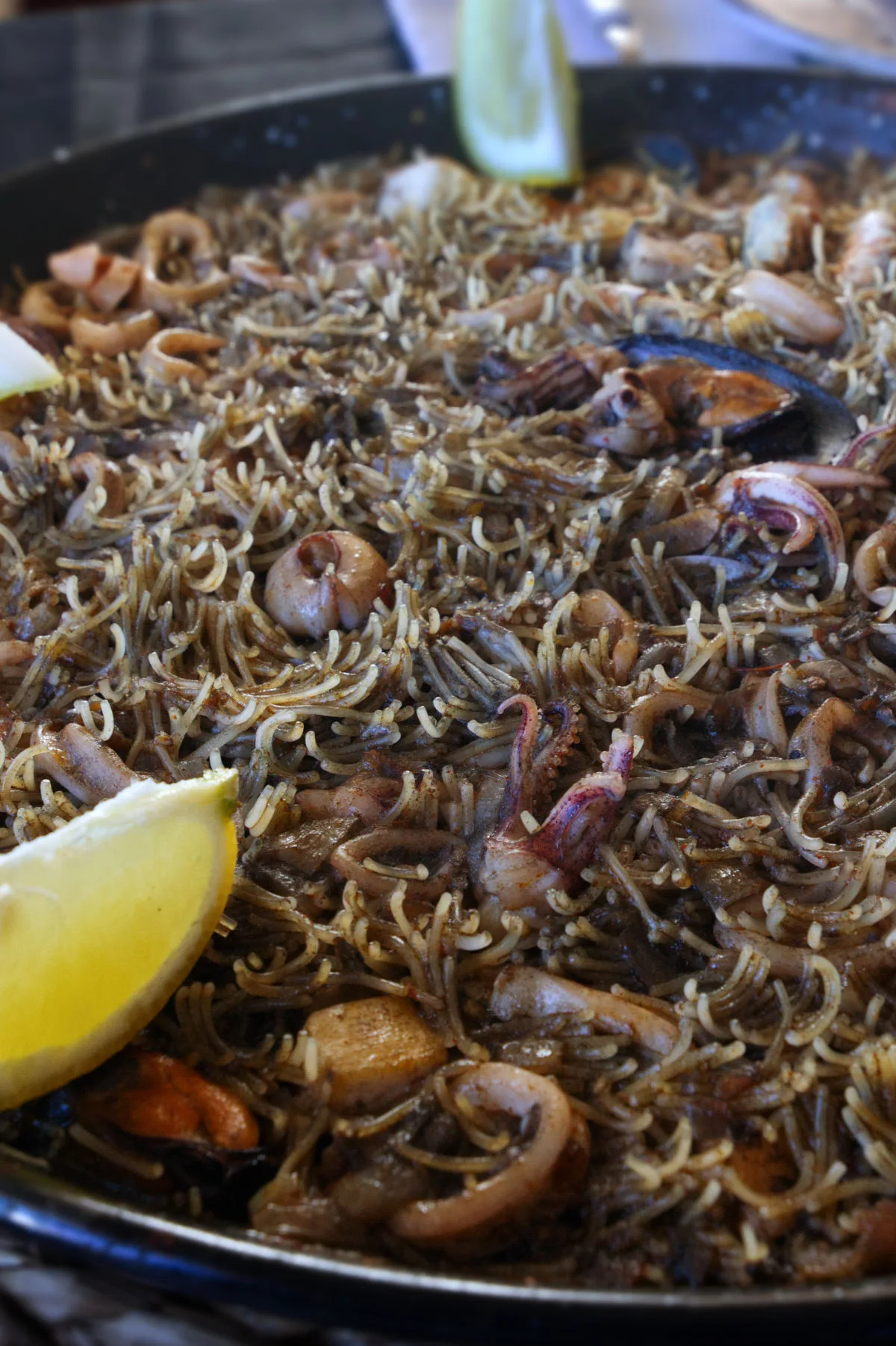Fideua Negra With Seafood
(Fideuà Negra Con Mariscos)

Indulge in the captivating flavors of the Mediterranean with this exquisite rendition of Fideua Negra with seafood. Hailing from the Valencia region, Fideuà Negra (also known as Seafood Fideuà Negra or Black Squid Ink Fideuà) is a classic Spanish dish that combines seafood with thin pasta (similar to vermicelli) cooked in a squid ink-infused broth.
It’s a variation of the more well-known “Fideuà” dish — these are similar to paella but made with pasta instead of rice. The addition of squid ink gives the dish its distinctive black color and a unique seafood flavor. It’s the perfect recipe for entertaining or sharing with friends.
This recipe makes 4-6 servings.
Seafood Recipes | Main Meal Recipe | Authentic Spanish Recipe | Summer Recipe | Healthy | Mediterranean Recipe | Made in Under 1 Hour
Serving:
Main for 4-6
Ready in:
Under 1 hour
Skill level:
Moderate
Serve with:
Alioli and lemon slices
This post may contain affiliate links.
How To Make Fideua Negra With Seafood
Equipment
- A wide shallow pan (or large paella pan)
Ingredients
- 17oz. (500g) thin pasta (we used Gallo brand Fideo No. 1) or vermicelli broken into small pieces)
- 21oz. (600g) mixed seafood (such as shrimp, squid, mussels, and clams), cleaned and prepared
- 1 onion, finely diced
- 2 cloves garlic, minced
- 1 red bell pepper, diced fine
- 2 tomatoes, grated and skin removed
- 2-3 tablespoons squid ink
- 1 teaspoon La Dalia Spanish Sweet smoked paprika
- 1/2 teaspoon ground black pepper
- 1/4 teaspoon cayenne pepper (adjust to taste)
- 4 cups fish or seafood broth
- 4 tablespoons Extra Virgin Olive Oil
- Salt, to taste
- Fresh parsley, chopped, for garnish
- 1 lemon in wedges (for garnish)
Instructions
- Prepare or heat your broth.
- Heat a wide, shallow pan or paella pan over medium heat. Add a few tablespoons of olive oil.
- Add the chopped onion and diced red bell pepper to the pan. Sauté until the onion is translucent and the pepper is softened.
- Add the minced garlic and grated tomato to the pan. Cook for a few minutes until the tomato has reduced and the mixture becomes fragrant.
- Sprinkle the sweet paprika, ground black pepper, and cayenne pepper into the pan. Stir well to combine the spices with the other ingredients.
- Add the seafood to the pan and cook briefly until it starts to turn opaque. This will only take a few minutes. Remove the seafood from the pan and set it aside.
- In the same pan, add the thin pasta (fideo or vermicelli pieces) and toast it for a couple of minutes, stirring frequently, until it starts to turn golden brown.
- Dissolve the squid ink in the fish or seafood broth. Pour the squid ink-infused broth over the toasted pasta in the pan. Stir well to distribute the ink and evenly coat the pasta.
- Bring the mixture to a simmer and let it cook for about 8-10 minutes, or until the pasta is cooked and the broth has been mostly absorbed. You can add more broth if needed.
- About halfway through the cooking time, gently stir in the cooked seafood, ensuring they are evenly distributed throughout the dish.
- Once the pasta is cooked and the liquid has been absorbed, remove the pan from the heat. Let the Fideuà Negra rest for a few minutes before serving.
- Garnish the dish with chopped fresh parsley and lemon wedges before serving.
Where Does Fideuà Negra Originate?
Fideuà Negra originates from the Valencian region of Spain, specifically from the coastal town of Gandia. The dish is closely related to paella, a well-known Spanish rice dish, and is considered a variation of the traditional Fideuà.
Fideuà itself is believed to have been created in the 20th century as a result of experimentation with paella. The story goes that a group of fishermen in Gandia decided to make a paella but realized they didn’t have rice. Instead, they used thin pasta (fideo) and created a similar dish, which eventually became known as Fideuà.
Over time, different variations of Fideuà emerged, including the addition of squid ink to create the “Fideuà Negra.” This variation is particularly popular in coastal areas of the Valencia region and other parts of Spain due to its unique taste and striking presentation.
Check out these other great Fideuà recipes:

Types of Fideos
Much like pasta in Italy, fideuà pasta comes in a variety of different shapes and sizes. There are two main types of pasta that are commonly used for this dish. If you’re living anywhere in Spain, you’ll have no issue finding any of these. In other parts of the world, a Spanish grocery store will often stock them otherwise you can order a packet online.
Fideo
The most common is the thin vermicelli-like noodle (except they’re very short pieces), and this is often referred to by many brands as ‘Fideo’, and there are often 3 or 4 different sizes or ‘grades’ of the fideo pasta, usually cataloged as Fideo No. 1, 2, 3, 4, or No. 5.
These thin fideos cook a little faster than the fatter round-shaped fideuà pasta, so it’s worth trying out a few different types to see what you like best.
Fideuà
Spanish fideuà pasta looks a lot like small macaroni elbow pasta in shape and size. It takes a little longer to prepare compared to the thinner variety of fideo mentioned above. I prefer the fideuà pasta, mainly because of the lovely texture of the noodles and how they blend well with the seafood and other ingredients.
Noodle Substitute for Fideuà
If you can’t find the Spanish fideo or fideua noodles, don’t despair. There are a few cheats that can get you through your noodle drought! Thin rice vermicelli noodles can also be substituted if you break them into pieces around an inch/2.5cm long. Just monitor them during cooking time.
Cooking with Squid Ink
Cooking with squid ink can be a unique and rewarding culinary experience, but it can be a little daunting at first when using squid ink in dishes for the first time.
First things first, wear an apron and gloves and be sure to clean up any squid ink immediately in the event of any spills. After all, it is ink and it will easily stain clothes, chopping boards, and even untreated benchtops if left for more than a few minutes.
Remove squid ink stains from clothes
Fortunately, squid ink can be washed off your skin fairly easily with some warm soapy water and a good scrub. For clothes, you’ll want to act fast and rinse the stained area immediately, then dab the stain with some liquid detergent and gently massage the stain. It should begin to disappear after a minute or two. Soak and wash the garment to completely remove the stain.
Remove squid ink stains from benchtops
Immediately dilute the affected area with water and gently blot at the stain with a kitchen towel. Do not scrub the area vigorously, it may make it worse. If water doesn’t remove the stain, use a mild soap solution and gently blot and rub the stain until it disappears. Dry the benchtop with a clean kitchen towel.

Tips for cooking with squid ink
OK, now we’ve got all the dirty work out of the way, let’s dive into a few helpful tips when cooking with squid ink:
- Storing: Store squid ink in the refrigerator according to the instructions on the packaging.
- Balancing Flavors: Squid ink has a mild briny flavor that can be intensified with some salt. Use it sparingly to avoid overpowering the dish. A little goes a long way.
- Pairing Ingredients: Squid ink pairs well with seafood, pasta, rice, and other ingredients that can absorb its flavor.
- Enhancing Color: Squid ink adds a deep black color to dishes. If you’re looking to achieve a striking presentation, consider using it in contrast with lighter accompaniments.
- Dissolving Squid Ink: Squid ink can be quite thick. To incorporate it evenly into a dish, it’s a good idea to dissolve it in a small amount of warm liquid (like broth or wine) before adding it to the recipe.
- Serving: When serving dishes with squid ink, consider adding a touch of color contrast, such as a garnish of fresh herbs, or a sprinkle of grated lemon zest.
- Quality Matters: Use high-quality squid ink for the best flavor and results. Fresh squid ink tends to have a more vibrant flavor than preserved versions. Always check the expiry date on the packaging before using it in any cooking.
Awareness of Allergies: Some people may have allergies to seafood or shellfish, which could extend to squid ink. Make sure to inform your guests if you’re using squid ink in a dish.

Do I need a paella pan to make a fideua?
Short answer, no! While using a traditional paella pan is common when making Fideuà, it’s not an absolute requirement. You can still make a delicious Fideuà without a paella pan, using a wide, shallow skillet or a large frying pan as an alternative.
The key to making Fideuà is to have a wide cooking surface that allows the thin pasta (fideo or vermicelli) to toast evenly and cook in a single layer. This helps achieve the characteristic texture of the dish.
FAQs and Cooking Tips
Can I use different types of seafood in Fideuà Negra?
Absolutely! Fideuà Negra is versatile, and you can use a variety of seafood such as shrimp, squid, mussels, clams, or even fish. Choose your favorites and adjust the quantities based on your preferences.
How do I prevent the squid ink from staining everything?
Squid ink can be messy and staining. To minimize the mess, wear gloves while handling it, use utensils you don’t mind staining, and work carefully. If a spill occurs, clean it promptly with cold water and soap before it sets.
Can I substitute regular pasta for fideo or vermicelli?
We get it, fideo and fideua noodles can be tricky to source in some places of the world outside of Spain. Traditional fideo noodles are integral to the texture and appearance of Fideuà. While you can experiment with different types of pasta, keep in mind that the results might not be the same as with traditional Spanish noodles.
Is there an alternative to a paella pan for making Fideuà?
Yes, if you don’t have a paella pan, you can use a wide, shallow skillet or frying pan. The key is to ensure the pasta can toast and cook evenly in a single layer. This might affect the presentation slightly, but the flavors should remain intact.
Can I prepare Fideuà Negra in advance?
Fideuà is best enjoyed fresh, as the pasta’s texture can change if left for too long. While you can prepare some components in advance (like chopping vegetables or cleaning seafood), it’s recommended to cook and assemble the dish just before serving for the best results.
Nutrition Facts
| Serving size: 200g | |
| Servings: 6 | |
| Amount per serving | |
| Calories | 557 |
| % Daily Value* | |
| Total Fat 12.2g | 16% |
| Saturated Fat 2.3g | 12% |
| Cholesterol 115mg | 38% |
| Sodium 708mg | 31% |
| Total Carbohydrate 77.5g | 28% |
| Dietary Fiber 4.6g | 16% |
| Total Sugars 6.2g | |
| Protein 28.7g | |
| Vitamin D 0mcg | 0% |
| Calcium 73mg | 6% |
| Iron 8mg | 45% |
| Potassium 344mg | 7% |
| *The % Daily Value (DV) tells you how much a nutrient in a food serving contributes to a daily diet. 2,000 calorie a day is used for general nutrition advice. | |


Fideua Negra With Seafood (Fideuà Negra Con Mariscos)
Equipment
- A wide shallow pan (or large paella pan)
- A pot for heating the stock
- Ladle
- Wide spoon
Ingredients
- 17 oz. 500g thin pasta (we used Gallo brand Fideo No. 1) or vermicelli broken into small pieces)
- 21 oz. 600g mixed seafood (such as shrimp, squid, mussels, and clams), cleaned and prepared
- 1 onion finely diced
- 2 cloves garlic minced
- 1 red bell pepper diced fine
- 2 tomatoes grated and skin removed
- 2-3 tablespoons squid ink
- 1 teaspoon La Dalia Spanish Sweet smoked paprika
- 1/2 teaspoon ground black pepper
- 1/4 teaspoon cayenne pepper adjust to taste
- 4 cups fish or seafood broth
- 4 tablespoons Extra Virgin Olive Oil
- Salt to taste
- Fresh parsley chopped, for garnish
- 1 lemon in wedges for garnish
Instructions
- Prepare or heat your broth.4 cups fish or seafood broth
- Heat a wide, shallow pan or paella pan over medium heat. Add a few tablespoons of olive oil.4 tablespoons Extra Virgin Olive Oil
- Add the chopped onion and diced red bell pepper to the pan. Sauté until the onion is translucent and the pepper is softened.1 onion, 1 red bell pepper
- Add the minced garlic and grated tomato to the pan. Cook for a few minutes until the tomato has reduced and the mixture becomes fragrant.2 cloves garlic, 2 tomatoes
- Sprinkle the sweet paprika, ground black pepper, and cayenne pepper into the pan. Stir well to combine the spices with the other ingredients.1 teaspoon La Dalia Spanish Sweet smoked paprika, 1/2 teaspoon ground black pepper, 1/4 teaspoon cayenne pepper, Salt
- Add the seafood to the pan and cook briefly until it starts to turn opaque. This will only take a few minutes. Remove the seafood from the pan and set it aside.21 oz. 600g mixed seafood (such as shrimp, squid, mussels, and clams), cleaned and prepared
- In the same pan, add the thin pasta (fideo or vermicelli pieces) and toast it for a couple of minutes, stirring frequently, until it starts to turn golden brown.17 oz. 500g thin pasta (we used Gallo brand Fideo No. 1) or vermicelli broken into small pieces)
- Dissolve the squid ink in the fish or seafood broth. Pour the squid ink-infused broth over the toasted pasta in the pan. Stir well to distribute the ink and evenly coat the pasta.2-3 tablespoons squid ink
- Bring the mixture to a simmer and let it cook for about 8-10 minutes, or until the pasta is cooked and the broth has been mostly absorbed. You can add more broth if needed.
- Once the pasta is cooked and the liquid has been absorbed, remove the pan from the heat. Let the Fideuà Negra rest for 10 minutes before serving.
- Garnish the dish with chopped fresh parsley and lemon wedges before serving.Fresh parsley, 1 lemon in wedges

0 Comments